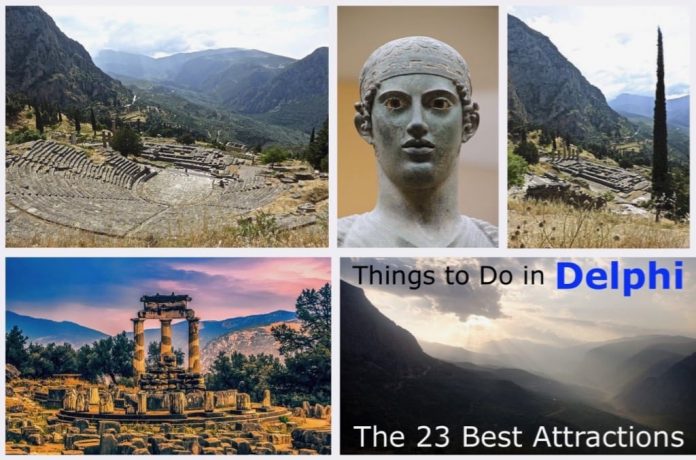Here I show you the best things to do in Delphi from my own insight during a trip of mine to Delphi over two days, while also digging around for some other great places I missed.
Delphi is a small tourist town located on Mount Parnassus in mainland Greece. The biggest attraction in Delphi has to be the Temple of Apollo.
The prophetic oracle of Apollo in Delphi isn’t operating nowadays like it once famously did during ancient times, but Delphi still has some really awesome attractions.
Unfortunately I missed out on way too many of these attractions during my solo trip simply due to the fact that I wasn’t aware of many of them at the time of my visit.
All I had on my mind was the Temple of Apollo. My mind was stuck on seeing the Temple of Apollo, like thinking about seeing the Eiffel Tower and forgetting about everything else.
Anyone reading this post is in luck because this is pretty much all you need to know.
Like many tourists I also didn’t give myself enough time in Delphi to do it justice especially with the benefit of hindsight.
I would have loved to have stayed an extra night or two in Delphi at the very least, especially now that I’ve come up with this full on list of best things to do in Delphi.
Best Things to Do in Delphi: 23 Delphi Attractions
Once you’re fully aware of all of these 23 attractions in Delphi and the tourist spots close by, you’ll probably want to rethink your agenda if you ever plan a trip to Delphi.
Believe me you won’t regret staying an extra day or two in this brilliant part of the world.
You can fully appreciate why the God Apollo wanted to base the oracle in Delphi. The place is awesome! Here’s where to go:
1. Delphi Archaeological Museum
The archaeological museum in Delphi was a real eyeopener.
My own favourite exhibit in the Delphi museum was the Sphinx of Naxos which once stood on a ten meter tall Ionic style column below the Apollo Temple terrace. It was excavated at Delphi in 1861.
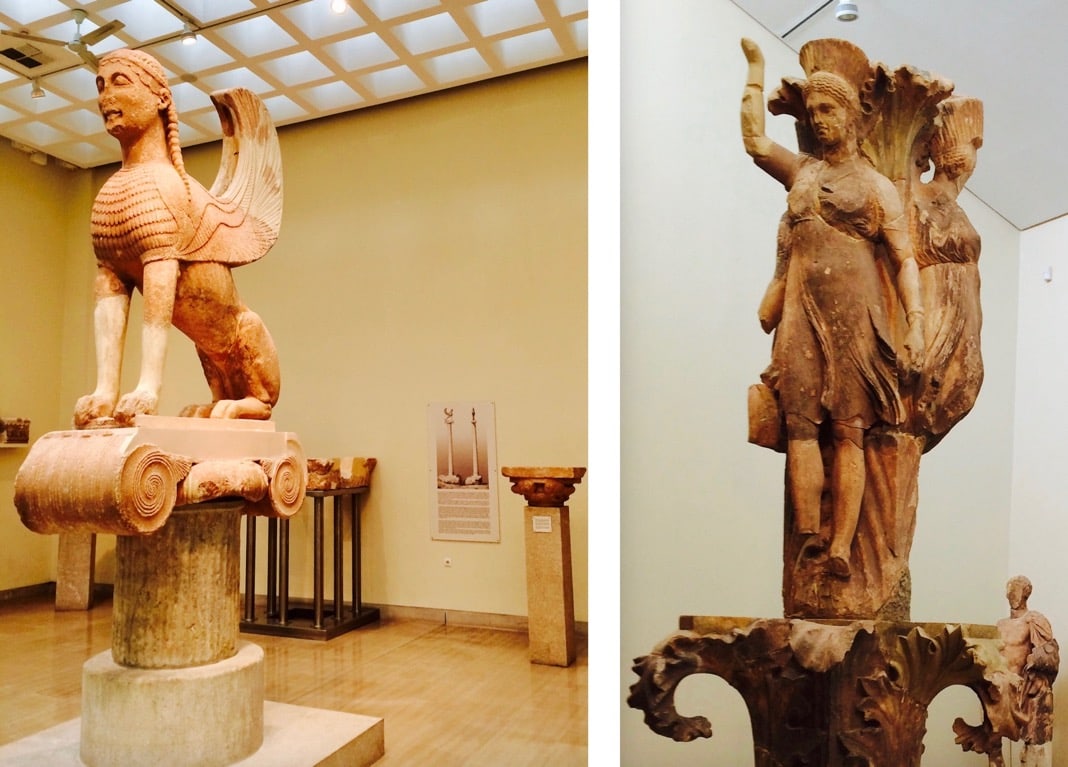
The Dancers of Delphi can be seen on the right hand side. Found near the sanctuary of Pythian Apollo at Delphi, it shows three figures in high relief on top of an acanthus column, which is why it is also known as the Acanthus Column.
One of the biggest attractions inside the Delphi Archaeological Museum is the famous statue of the Bronze Charioteer of Delphi.
The charioteer is seen wearing a distinctive charioteers’ long chiton. The figure symbolizes a victory long ago at a chariot race of the Pythian games.

Other attractions inside the Delphi Archaeological Museum
Chryselephantine statues of Apollo and Artemis.
The Omphalos (Navel of the Earth) which is a stone that marks the centre of the earth, which was determined by two golden eagles sent by Zeus.
The original Omphalos is in the Delphi museum and a replica is situated at the archaeological site near the Temple of Apollo. The Greek Gods don’t muck around.
You can see a picture of the original and a copy of the Omphalos stone further down in this post. Yes, I have include this stone as one of the 23 best attractions in Delphi as well.
The museum houses twin statues by Polymedes of Argos, conventionally known as “Kleobis and Biton” which look to me as if they belong in Egypt more so than in Greece.
The frieze from the Siphnian Treasury tells the story of how Herakles once challenged Apollo for his tripod in Delphi, the seat of the Greek God’s power. I’m not sure why the demigod wanted to do this.
If you’re in Delphi you won’t want to miss out on the Delphi Archaeological Museum even if it is just to see the Sphinx. It is very impressive!
2. Ancient Theatre
The ancient theatre at Delphi further up the hill from the Temple of Apollo offers fantastic views of the entire sanctuary and the valley below.
This is where theatrical, singing and musical events of the Pythian Games were held.
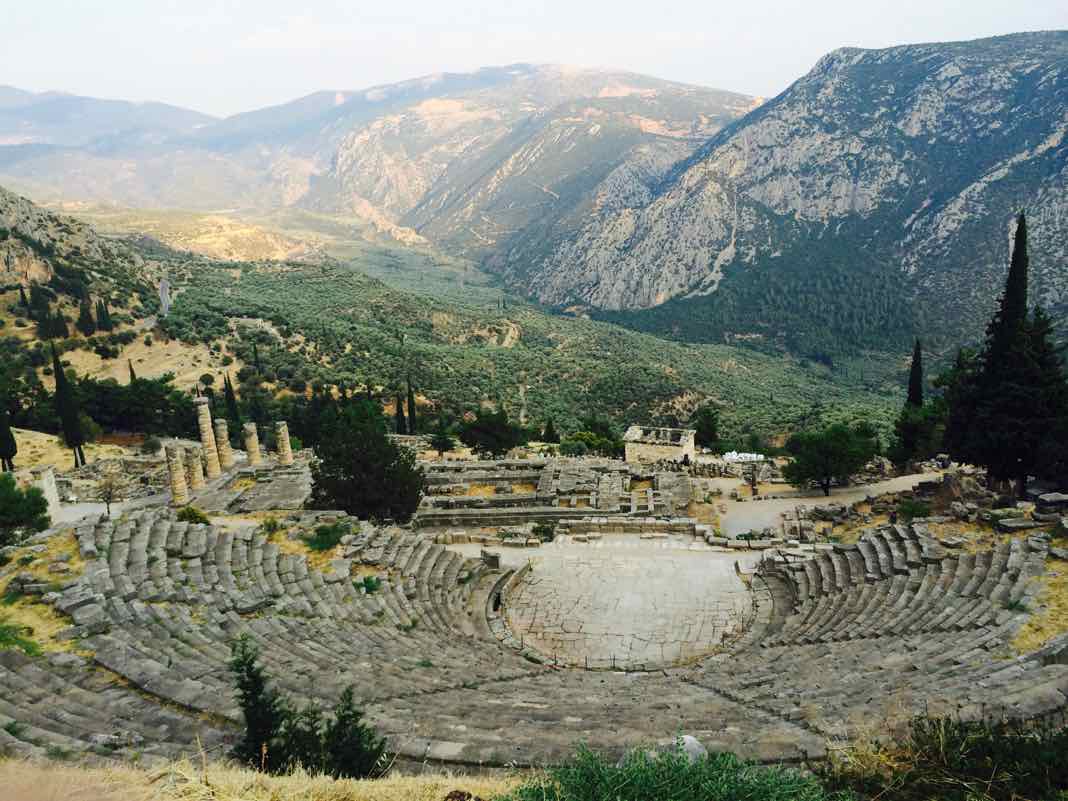
The theatre seats about five thousand spectators.
3. The Sacred Way – Delphi
The Sacred Way meanders up to the Temple of Apollo and continues on up to the theatre and the stadium.

At one time the Sacred Way was gloriously lined with statues and numerous small treasure-houses called “Treasuries” or “thêsauroi”.
This is where gold and other valuables were kept for safekeeping by individual city-states and colonies.
The ruins of the Treasure-House of the Athenians is still seen in Delphi today.
4. Athenians Treasury
The treasury dedicated by the Athenians is much like a scaled down temple with sculpted decorations on the highest parts of the structure including metopes, pediments and acroteria.
The building’s metopes depict scenes from Greek mythology showing the deeds of demigod Herakles (North side) and cycle of the Athenian hero Theseus (South side).
The metopes showing Theseus’ victory over the Minotaur is displayed in the Delphi Museum.
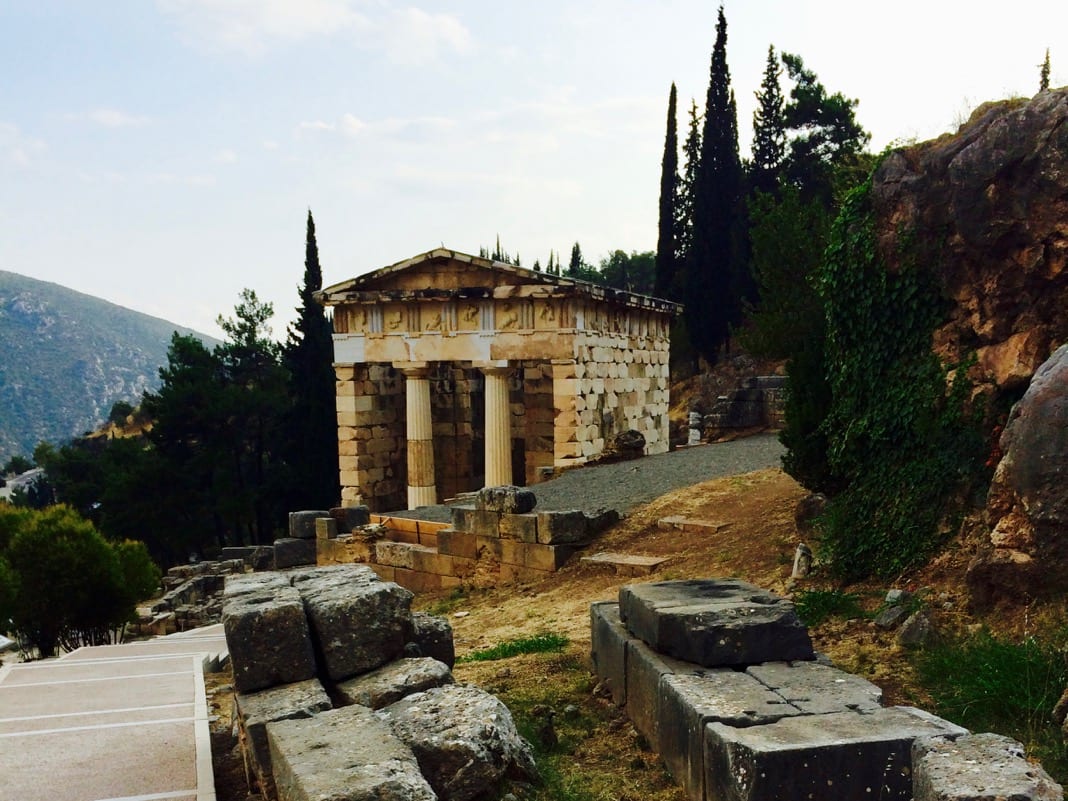
It was built by the Athenians right after the victory at Marathon in 490 BC with the spoils taken from the battle of Marathon.
The newer building constructed out of Parian Marble replaces an older Treasury of the Athenians.
The Treasury you see today was re-erected in 1904-1906 with more than 80 percent of the material from the original building.
Alongside the treasury on the Sacred Way was a rectangular limestone base showing an inscription with the words:
AΘENAIOI T[O]I APOLLON[I AΠO MEΔ]ON AKROΘINIA TEΣ MARAΘ[O]NI M[AXE]Σ
The Athenians to Apollo as offerings from the Battle of Marathon, taken from the Mede
A hymn to Apollo with musical notation was also discovered on the Treasury’s rear wall.
5. The Stadium
The stadium of Delphi lies on the highest spot of the archaeological site of Delphi beyond the theatre and overlooks the sanctuary of Apollo.
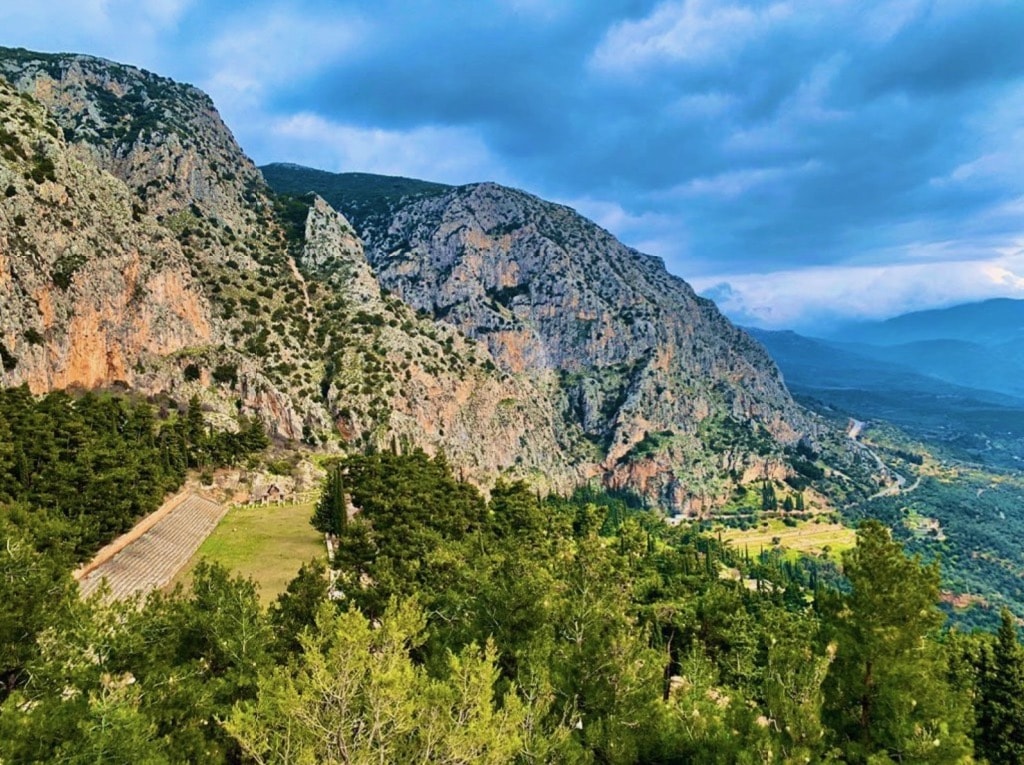
Τhe stadium of Delphi has a length of very close to 178 meters and happens to be the best preserved ancient stadium in Greece.
The stadium was used for events like the Pythian games, the predecessor to the Olympic Games.
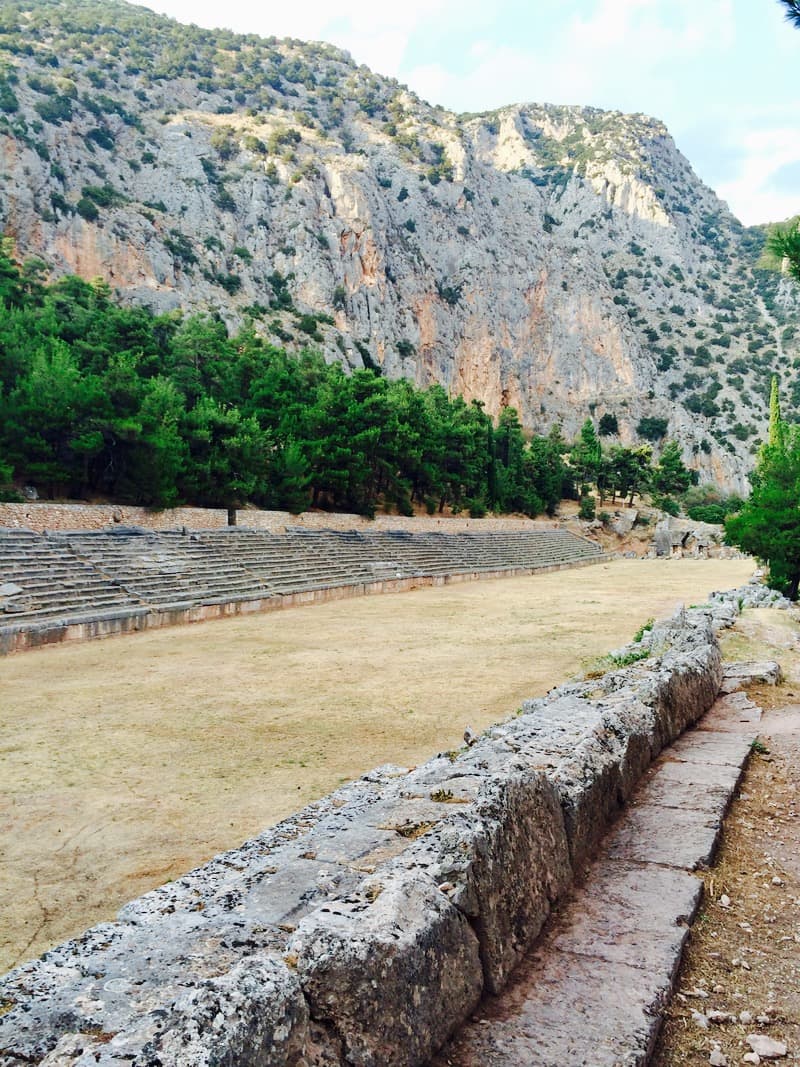
The Pythian games included foot races measured in relation to the length of the stadium.
The “stade” was a sprint of one length of the stadium. The “diaulos” was run over two lengths, and the armed diaulos was a race of two lengths while wearing armor.
An endurance race of 18-24 laps on the stadium (about 3 miles) was called the “dolichos”.
6. Omphalos Stone or Baetylus – Delphi
According to Greek mythology, Zeus released two golden eagles in different directions to determine the centre of the world.
The two birds met in Delphi so Zeus threw down a stone from the heavens to mark the spot.
As a result Delphi was believed to be the centre (navel) of the world among the ancient Greeks.
This sacred stone is referred to as the Omphalos, which in Greek means “belly-button”.
You will be able to see a concrete representation of the Omphalos in the Delphi sanctuary immediately before of the Athenians’ Treasury.
This plain looking conical shaped stone has such an interesting story behind it but you would never guess so by seeing the stone if you didn’t know anything about it.
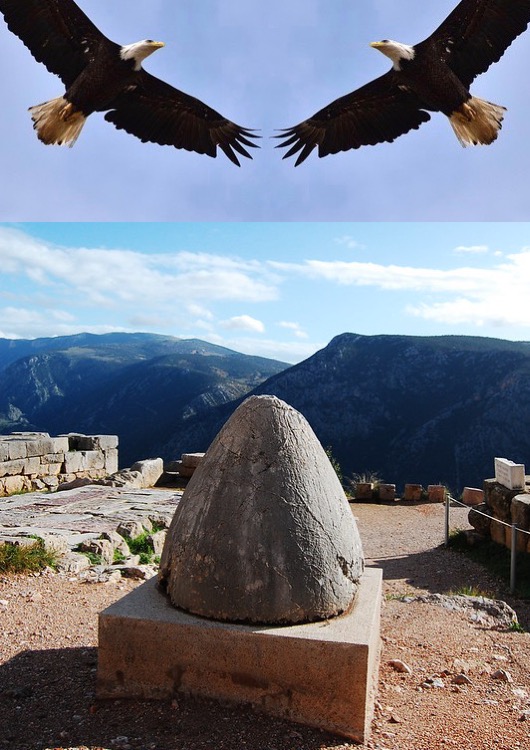
It is known from ancient sources that the sacred tripod, prophetic laurel and omphalos were in the “adyton”, a restricted area inside the cella of the Temple of Apollo. This is where the Pythia pronounced her oracles.
The most precious marble Omphalos is on display inside the Delphi Museum which is more of an artistic piece since it is obviously man-made.
It is regarded as a Hellenistic or Roman copy of the omphalos that used to stand in the adyton.
The relief decoration represents agrenon, a Greek word for a type of wool netting which originally covered the sacred object.
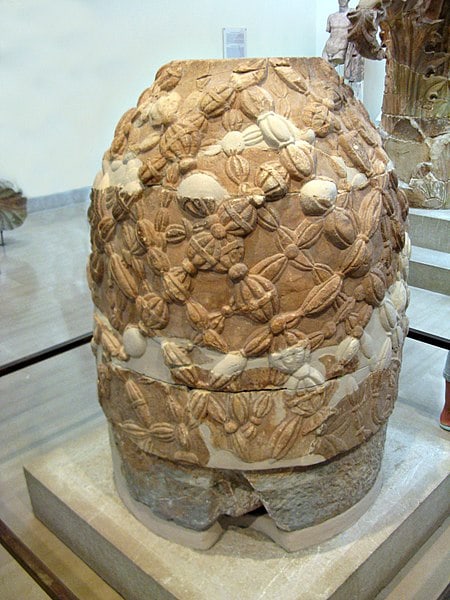
7. Castalian Spring
The Castalian Fountain is where worshippers of Apollo bathed before entering the site.
It is located close to the Museum of Delphi in an area with a stunning vantage point far above the valley.
It has been said that this is where Apollo killed the monster, Python, who guarded the spring.

Make sure you take a sip of the mineral water from the mountain spring while you’re in Delphi.
Two of the ancient fountains fed by the sacred spring still exist today as well as a modern fountain close to the street leading to the archaeological site of Delphi.
The archaic fountain houses a marble-lined basin surrounded by benches.
The Roman fountain is distinguished by niches carved on the rock and is situated about 50 meters higher from the archaic fountain.
8. The Serpent Column
The Serpent Column is also known as the Serpentine Column, Delphi Tripod or Plataean Tripod.
It is positioned at the end of the Sacred Way near the temple of Apollo.
You will only be able to see the stalk of three entwined serpents as the serpent heads were obviously removed at one point.
The serpent column celebrated the defeat of the Persians by 31 Greek city-states at Plataea in 479 BC.
It was made from a tenth part of the spoils taken from the Persian army. The one seen in Delphi is actually a replica.

According to some scholars, the bronze heads of the three entwined serpents once supported a small gold tripod, known as the Plataean tripod.
Delphi’s serpent column was removed to the hippodrome of Constantinople in 324 AD.
You can still see the original stalk of the serpents and its fragments in Istanbul today.
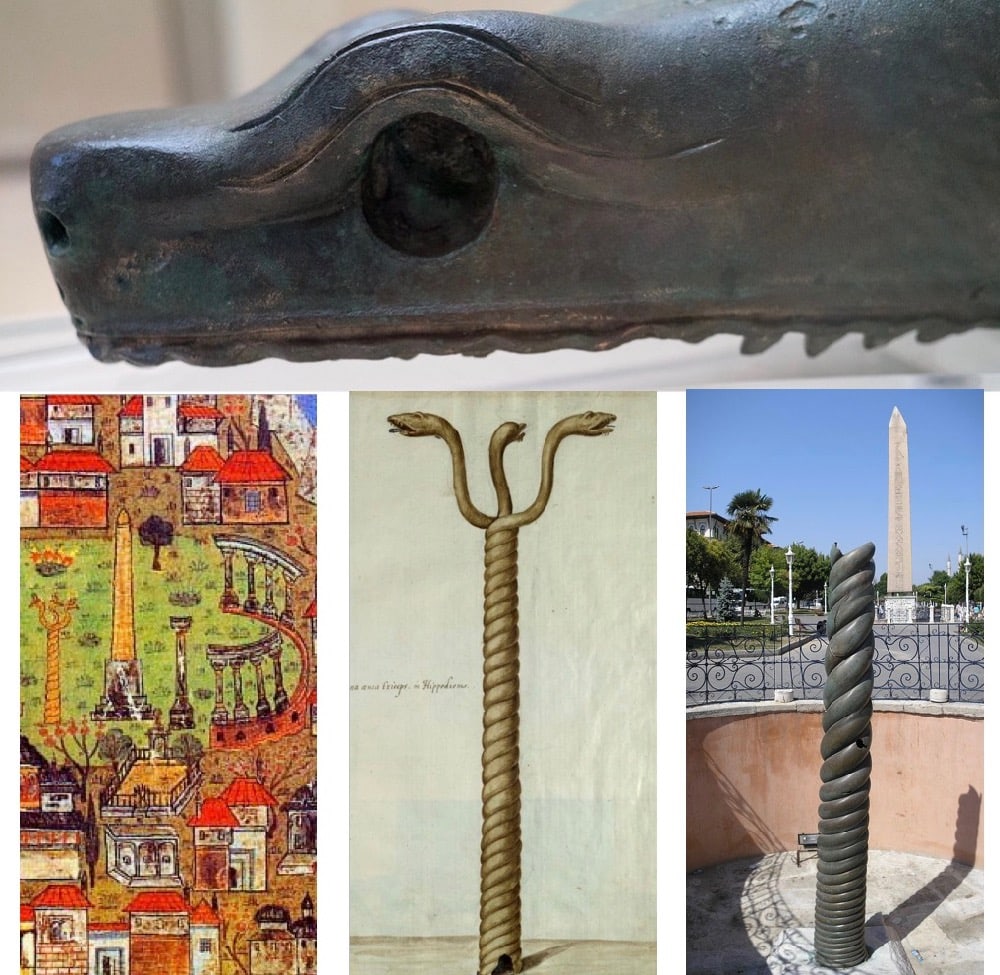
The original stalk of three entwined serpents is located in front of the Blue Mosque, in a large square where the hippodrome once stood in antiquity.
The serpent heads are lost apart from a small fragment exhibited in the Archeological Museum of Istanbul as seen above.
9. Arachova
Arachova is just 12km from Delphi, about 10 minutes away. The mountain village is situated at about 970m (3182ft) elevation on the southern slopes of Mount Parnassus, above the valley of the river Pleistos.
It is a very popular winter resort with many hotels and restaurants. There are also many cottages built according to Finnish style architecture.
This cosmopolitan town is the number one winter destination in Greece and as such attracts celebrities, families and the good-time seekers. It is a major drawcard for fashionistas.

I have heard silly rumours that even those who don’t know how to ski and have no clue whatsoever pretend they do by showing off all of their snow gear on their swanky cars just to look good.
Think of the Arachova like this: Mykonos is to the summer as Arachova is to the winter.
In summer Arachova is much quieter with many cafes, bars, nightclubs and restaurants closing down.
Many tourists stop by this small town on their way to Delphi as do bus tours. It would make for a good lunch or coffee spot before visiting Delphi or on the way back to Athens.
Arachova is smaller than the town of Delphi but this gem of a town is still a great place to base yourself.
In summer you can look forward to outdoor activities like hiking, mountain climbing and rock climbing.
Kouvelos is the most popular rock-climbing destination on Mount Parnassus, situated at an altitude of 1880m.
If you’re wanting to stay in Arachova during snow time be sure to book well in advance especially on weekends.
Tip: Arichova’s Folklore Museum is definitely worth a visit.
10. Mount Parnassos Ski Slopes
Season: December to mid/end April
Ski and snowboard fanatics will have loads of fun sliding down the slopes of Mount Parnassos.
Mount Parnassus Ski Centre is the closest ski resort to Athens and is only a 2 hour drive from the capital with roads all the way up to the ski centre. In winter it is usually cleared from snow daily.
You can understand why this would be a very popular activity during weekends and holidays.
Mount Parnassus Ski Centre is the biggest and the best organised ski center of the country.
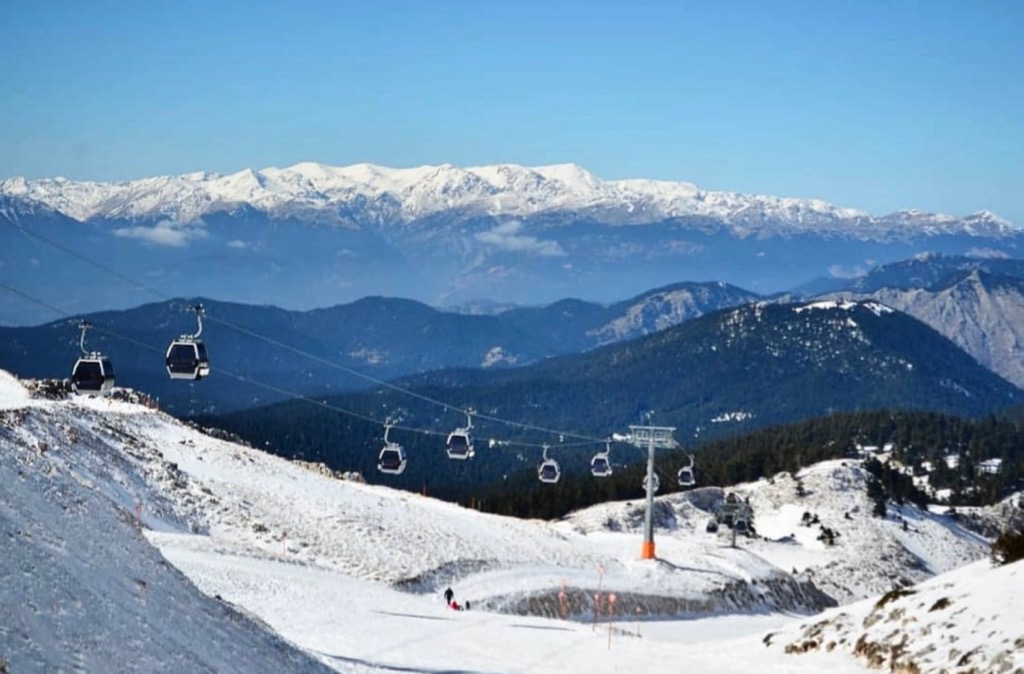
The infrastructure is a bit better than other ski resorts in Greece but not as great as other European resorts.
One big plus with Parnassos is that it does have some extra pulling power due to its association with Greek Gods and Greek nymphs.
If you want to visit Greece in winter then this is the place to be. I can’t believe I am saying this but visiting Greece doesn’t all have to be about the sun and magical beaches.
The Parnassos Ski Centre has two sections, Kellaria and Fterolakka, which together make up the largest and most famous ski centre in Greece.
A smaller ski centre with only a couple of drag lifts called Gerontovrahos is across a ridge from Kellaria.
Places to stay when visiting Mount Parnassus Ski Centre
Arachova at an altitude of 990m attracts thousands of visitors mainly during winter. Delphi at 610m attracts visitors all year long due to other attractions.
Both towns are excellent places to stay and even Delphi gets flooded with visitors who wish to go skiing or snowboarding at the two resorts on Mount Parnassus.
You can also find traditional villages at higher levels of Parnassus.
Agoriani or Eptalofos, is situated at the north-west part of Parnassus at a altitude of 830m and is considered the most beautiful village in the area. It has a beautiful town square and even has a waterfall for nature lovers.
11. Corycian Cave – Mount Parnassus
The Corycian Cave, also known as Pan’s Cave is located on the slopes of Mount Parnassus.
This cave was sacred to the Corycian Nymphs, the Muses, and a place of worship for goat-like god Pan.
Mount Parnassus is also sacred to Apollo. It is also said to be sacred to Dionysus and the Dionysian mysteries.
On top of that Parnassus was also home to Pegasus, the winged horse of Bellerophon, so they say.
That should be more than enough to entice any enthusiast of Greek mythology and hiking to want to see this mystical cave on Mount Parnassus.
The Corycian Cave is named after the nymph Corycia, one of Apollo’s partners.
It is 60m long, 26m wide and 12m high, and is made up of three chambers where you can see cave stuff like stalactites and stalagmites.

Ancient inscriptions in the entrance and a hollowed rock could possibly indicate a sacrificial altar within its depths which adds to its mystique.
Pan’s Grotto can be reached by walking along the ancient paths of Mount Parnassus, the same paths used by locals and pilgrims from ancient times.
Interestingly, over the centuries this cave was also a great hideout for locals from the occupying forces including the Persians, Turks and Germans.
A guided hiking tour of the Corycian Cave
In my opinion, the best thing to do in Mount Parnassus when seeking out the Corycian Cave is to go on a guided hiking tour, which means you won’t get lost!
One excellent trekking option worth considering is Trekking Hellas Parnassos.
I have noticed that trekking tours normally offer hotel pick ups from Delphi and Arachova.
Most of them seem to have a similar hiking itinerary as follows.
09:00: Pickup from your hotel in Delphi or Arachova
09:00 – 9:30: Transfer from Delphi to Livadi Plateau above Arachova (Altitude 1200m)
09:30 – 10:30: Hike to the cave
10:30 – 11:00: Explore the cave
11:00 – 12:00: Hike back to our car
12:00 – 12:30: Transfer back to Delphi or Arachova
All up the trek to the Corycian Cave can be done by going on a nice half-day trip. I am kicking myself for having missed out on this.
The initial part is supposed to be relatively flat which soon leads to a steeper pathway that zigzags for about 200 meters of altitude. It then leads to the top of a hill and the entrance to the cave.
Hiking to the Corycian Cave from Delphi
Many tourists like myself would also probably consider hiking to the Corycian Cave from Delphi.
This is the same footpath that took Pan’s worshippers up from the ancient temples of Delphi to the Corycian Grotto to celebrate mysterious rites.
You’re able to do this hike but it would take a whole day if you include the return walk.
The cave is now on the marked E4 European long distance trail and is about a 3.5 to 4 hour walk from Delphi.
If you’re adventurous ask for the starting point of the path near the Delphi Archaeological Museum.
I have read that one hiker completed the 20km long hike to the Corycian Cave and back in around 8 hours. Make sure you take enough food for the whole day out since you won’t be coming across any tavernas up there.
This would have to be one of the best hikes in Greece.
Top Tip: Don’t forget to bring a strong torch if you go without a tour guide and you want to explore this gloomy and forbidding place. This is one good reason to go as part of an organised group as I assume lighting would be taken care of.
Map of Delphi area showing the location of the Corycian Cave
Here’s a map of Delphi and Mount Parnassus showing you the location of the Corycian Cave (altitude 1310m) to give you a clearer idea of its location in relation to Delphi and Arachova.
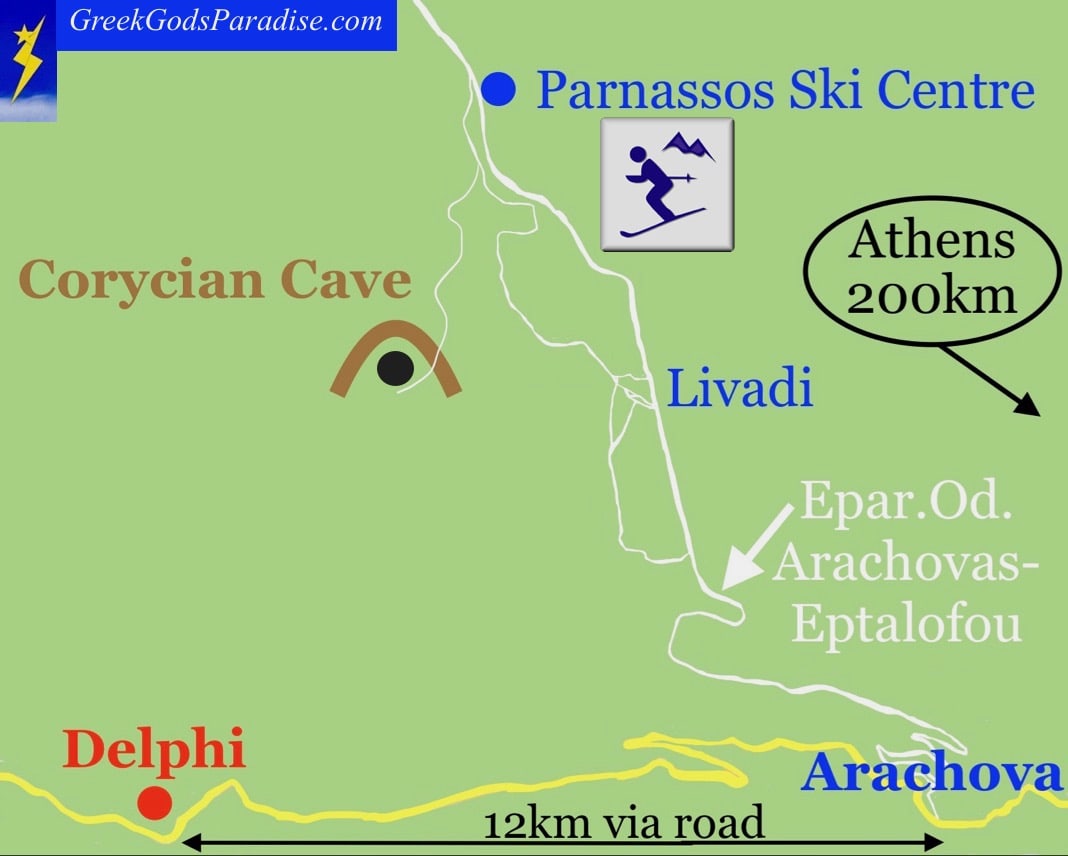
From what I can tell, going on a trek to the Corycian Cave with a guide most often involves starting off at Livadi, a beautiful plateau above Arachova.
Kalivia Livadi or Livadi as it is now known is a plateau at an altitude of 1100 m. It is about 10km away from Arachova.
The Corycian Cave can also be reached by car easily enough. There is a tarmac road that goes quite close to the cave entrance.
12. Hike from Delphi down to the seaside village of Kirra
Kirra was the ancient port of Delphi. A stone path will take you through an ancient valley of olive trees to the sea.
Here is a glimpse of what to expect when looking out over the rooftops of Delphi town towards Kirra and the sea in the distance.

The beauty about this great walk is that you can look forward to going for a swim if you do it in summer.
You can take a bus back to Delphi if you wish. First, you will have to walk or take a bus from Kirra to the bigger village of Itea.
Buses depart several ties a day to Delphi. One leaves for Delphi in the late afternoon at about 4pm and there is also another one in the evening.
Sounds like a good idea because you will then avoid the more tiring uphill climb back into Delphi.
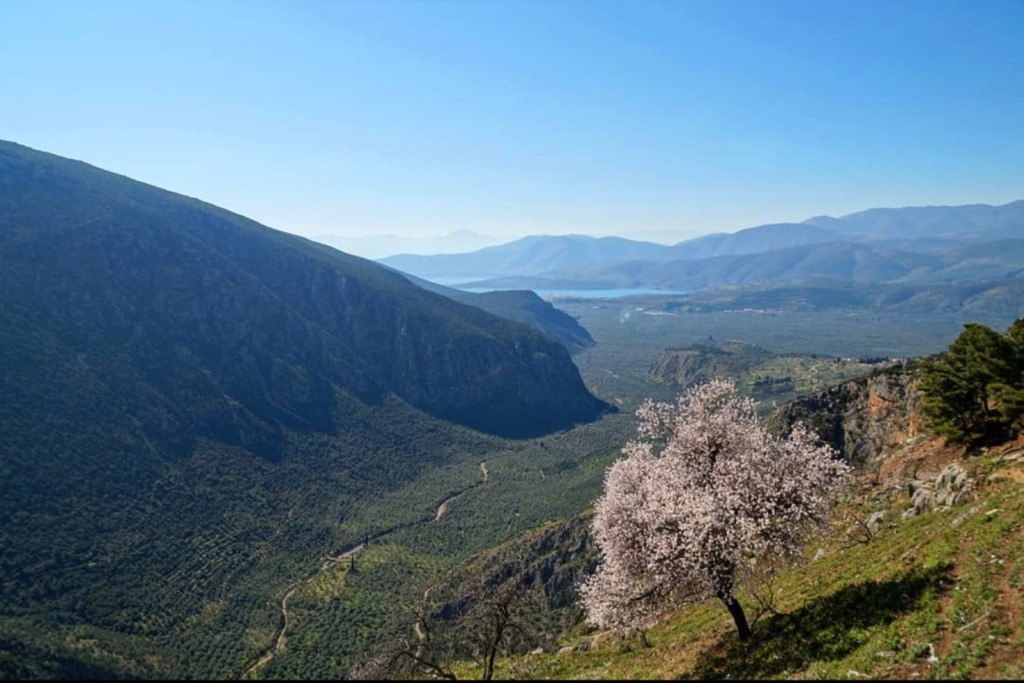
You can ponder over this walk at a higher altitude. I was eating at a restaurant in Delphi with an awesome view thinking about how great it would be to walk down to the sea.
If only I had another day in Delphi. Here’s another great reason for staying in Delphi for a few days.
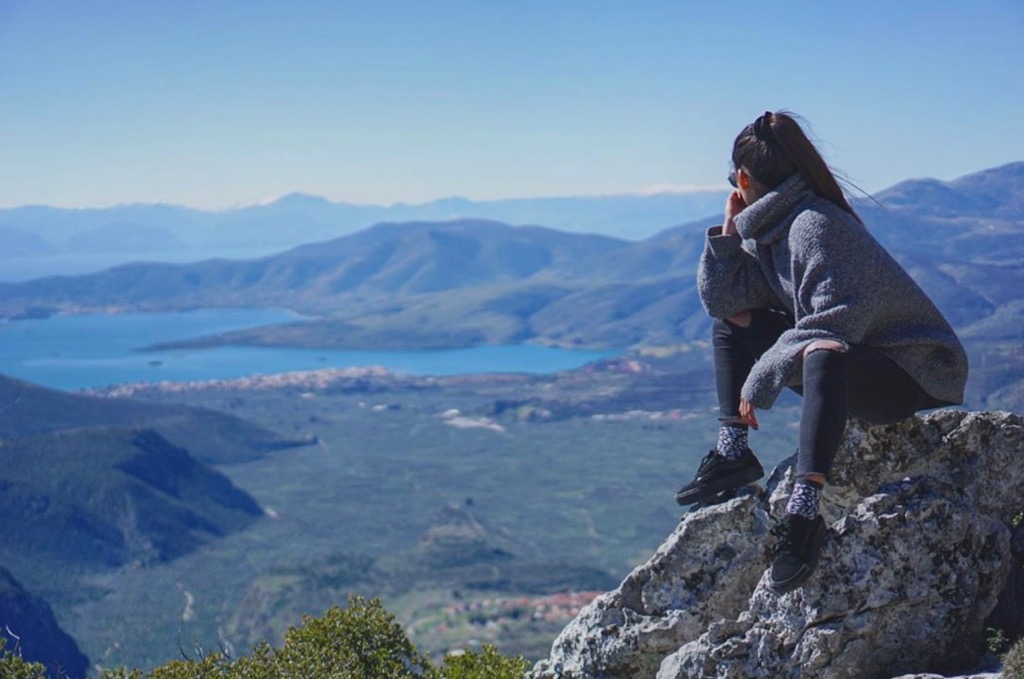
13. Ancient Roman Sarcophagi site
Don’t miss out on seeing an ancient Roman sarcophagi site. About 100m to the east of the Athena Pronaia is a road that turns to the south and goes downhill.
If you follow that road for about 1km, you’ll come across an ancient Roman sarcophagi site on the right side.
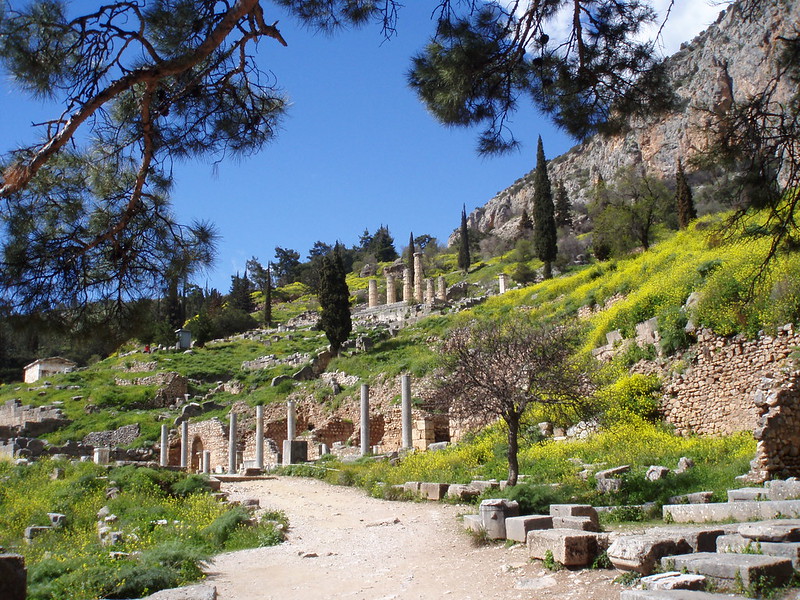
14. Museum of Delphic Festivals
Art lovers can visit the Museum of Delphic Festivals, a former neo-gothic two-storey house of the famous Greek poet Angelos Sikelianos and his American-born wife Eva Palmer.
The museum is also known as the Museum of Angelos and Eva Sikelianos.
In 1927 and 1930 the couple managed to orchestrate the Delphic Festivals with dance and theatre performances.
Eva even made costumes out of pure silk on her loom, which can be viewed in the house next to a piano.

They entertained large audiences from around the world when in the event was held in the ancient theatre of Delphi.
The couple made great efforts toward the revival of the “Delphic Idea” and even made attempts at reviving the Pythian Games.
Sadly, due to the huge cost in creating the Delphic Festivals it resulted in the bankruptcy of the Sikelianos family. They didn’t receive much financial support from the Greek state at the time.
The second festival in 1930 was the last one for dynamic duo. The house was abandoned just a few years later in 1933 and left to ruin.
Their efforts however did help inspire the creation of the European Cultural Center of Delphi in 1977.
The brick and stone building was restored by the European Cultural Center of Delphi in 1985 and is now their property. It opened its doors as a museum in the summer of 1991.
Museum of Delphic Festivals Attractions
The 1920s mansion-turned-museum has an interesting collection of artifacts related to ancient festivals and drama.
Inside you’ll find costumes from ancient drama performances, the famous loom of Eva Sikelianou, writings from the poet, including photographic and printed material from the Delphic Festivals.
The museum is located in a privileged position, next to the archaeological site of Delphi, on the slopes of Mount Parnassus. Visiting the house-museum provides amazing views too.
Angelos Sikelianos Museum in Lefkada town
The poet Sikelianos also has a house on the island of Lefkada which has also been turned into a museum.
The National bank of Greece purchased the house in Lefkada, after which it was renovated and made into a museum.
15. Open-Air Theatre FRYNIHOS – European Cultural Centre of Delphi
Watching a performance at the active open-air theatre called Frynihos is a must of you’re in Delphi.
This modern looking ancient theatre is part of the European Cultural Centre of Delphi.
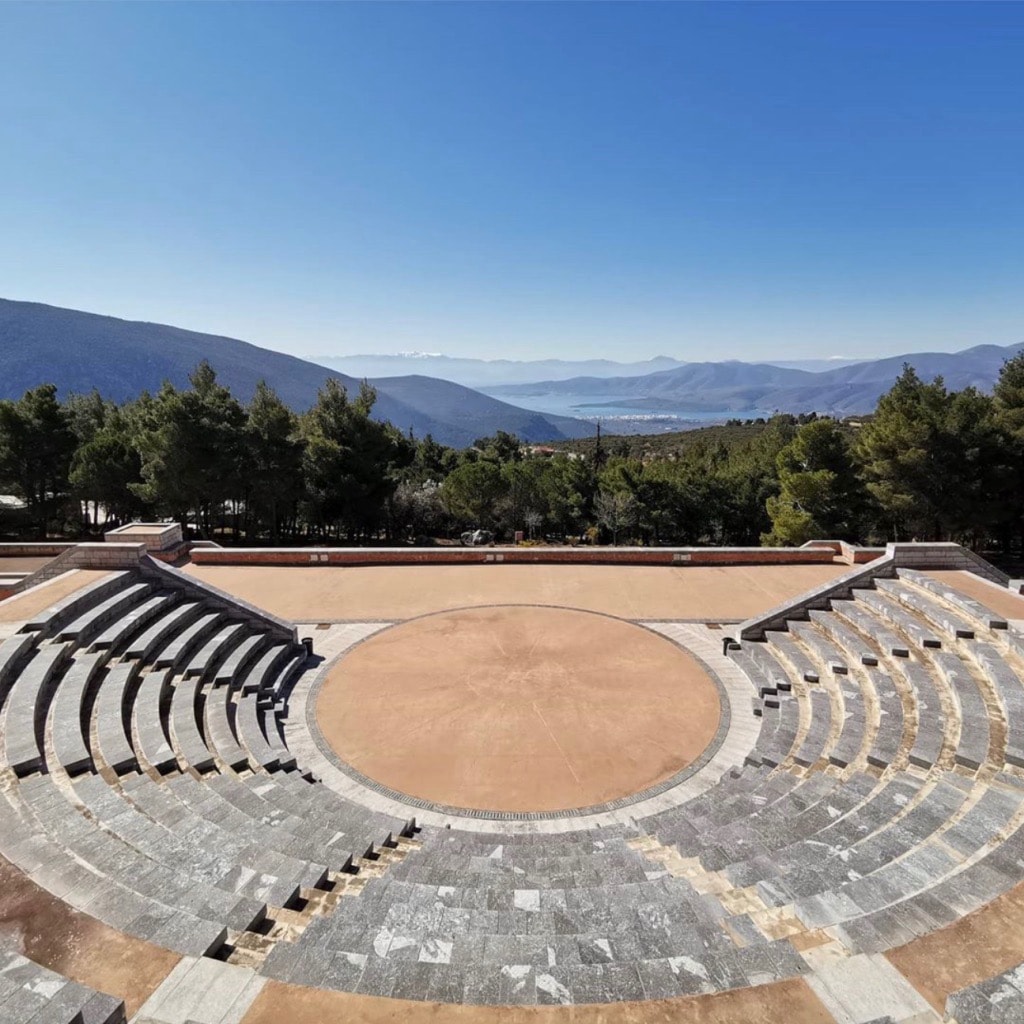
Who needs a performance when you have great views like this to look at.
16. Souvenir hunting in Delphi
You can’t leave Delphi without buying a souvenir. I bought myself an a great looking green Apollo chessboard.
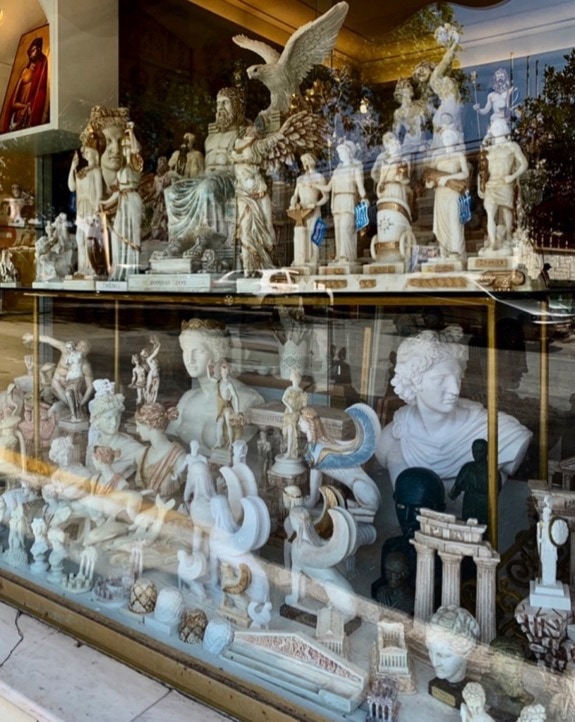
17. Eat at a Restaurant with an Awesome View
I had one of most memorable dinners at a restaurant at Delphi. The view from my table at the balcony was absolutely incredible.
I’m not sure of the name of the restaurant where I dined at but there are probably a few restaurants in Delphi with similar awesome views.
Most of the hotels and restaurants are said to have excellent observation decks. This restaurant looks amazing. Maybe I was at this one. It looks very familiar.

Here are some restaurants in Delphi to consider:
- Epikouros Taverna
- Vakhos Taverna – situated on the highest spot of Delphi’s central road. The view of the Corinthian sea is said to be unmatched.
- Chalet Maniati – the view from the gardens in the back are spectacular.
- To Patriko Mas
18. Stay at a Hotel in Delphi with a Pool
Having access to a pool in Delphi in summer would be a dream I tell you. This one looks good enough for me.
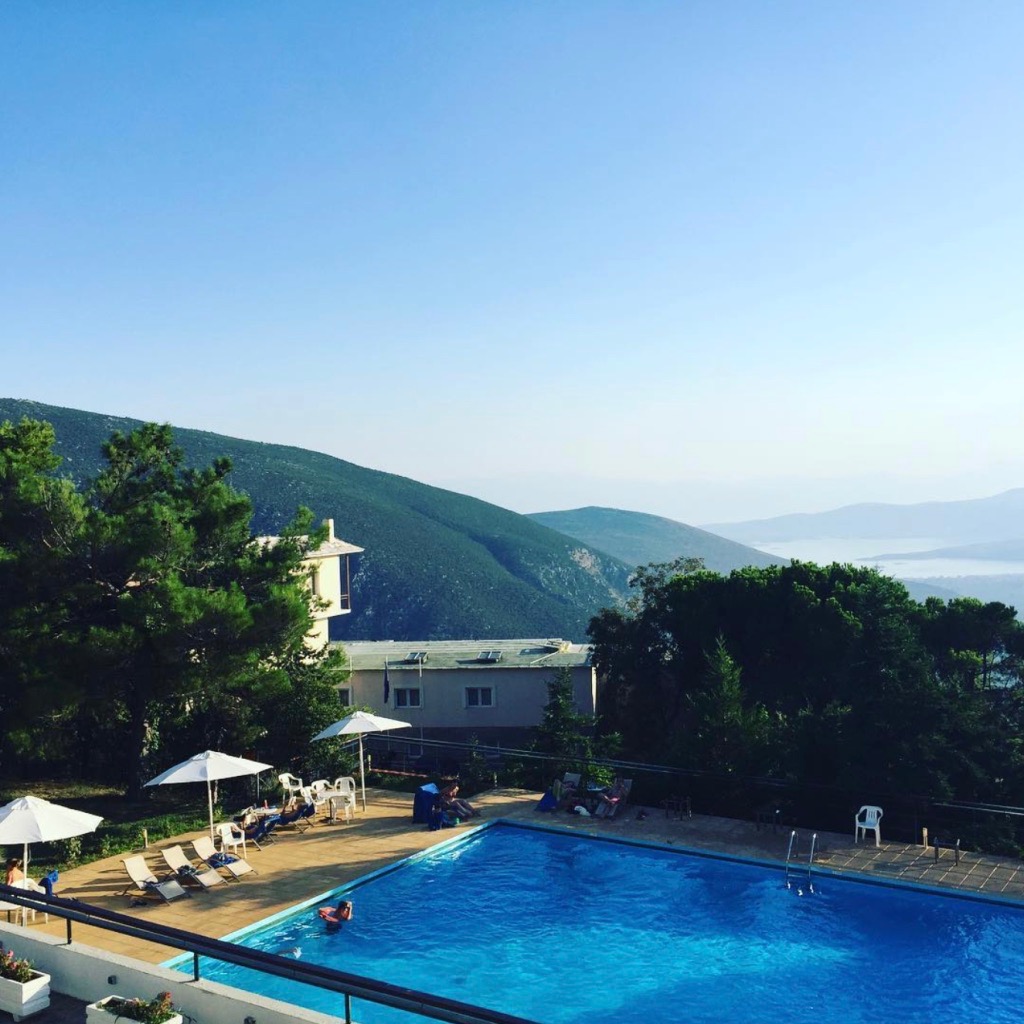
19. Galaxidi
Galaxidi is a picturesque town and a former municipality in the southern part of Phocis, which lies on the mouth of the Gulf of Itea. Since the 2011 it has become part of the municipality Delphi.
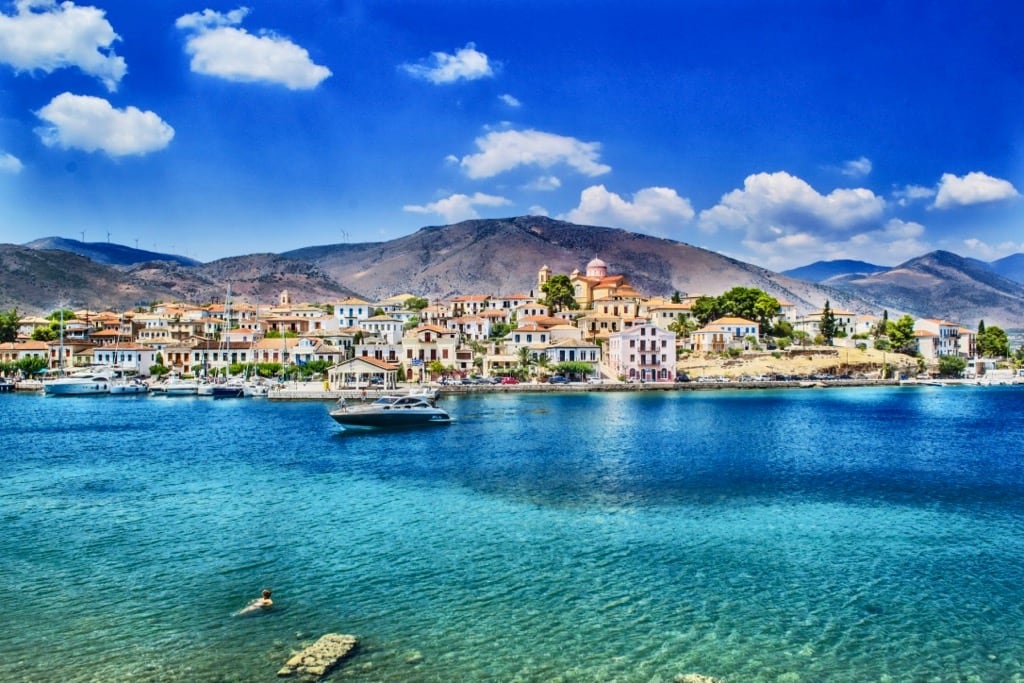
The best time to visit Galaxidi is when the Flour Throwing Festival takes place!
Every year the city gets covered with more than one ton of colored flour which is thrown on the locals and a mass of tourists who attend the crazy battle.
The flour battle occurs on a day which is known in the Eastern Orthodox Churches as Clean Monday, the day marking the start of 40 days of Lent until Easter.
They’re obviously rebelling against the cleanliness of the church. I am guessing you won’t come out looking clean if you take part in this battle. Apollo would be proud.
The seaside village is located 7 km southwest of Itea and 15 km southwest of Delphi.
20. Archaeological Museum of Amfissa
Just 20 minutes from Delphi, you will find the town of Amfissa, named after the daughter of Macar, son of Aeolus, and the mistress of Apollo.
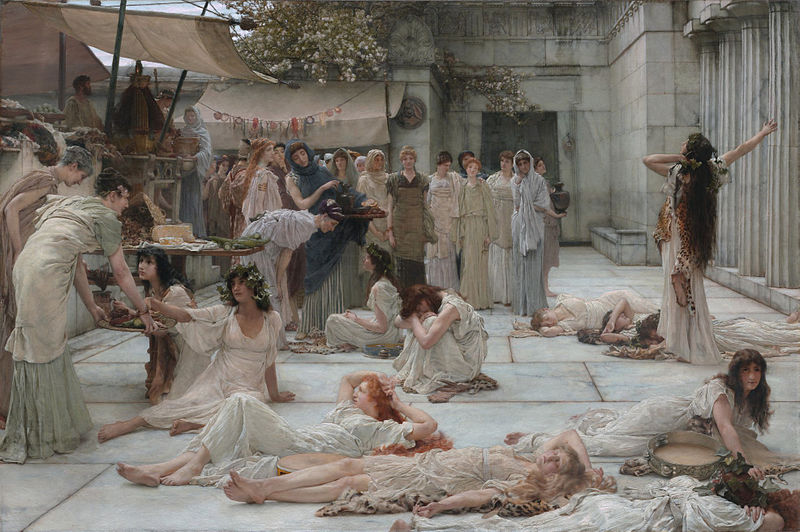
21. The Tholos of Delphi at the Sanctuary of Athena Pronaia
The Tholos was once a circular building with a Doric outer peristyle with 20 columns supported by a three step base.
Today, only three of the impressive columns are left standing after being re-erected in 1938.

The Tholos is dedicated to the Goddess of Wisdom, widely known as the protector of the Athenians.
This brilliant monument is a gateway to Delphi and it really does stands out in wonder when you first get a glimpse it when arriving into Delphi town.
The monument is in a great location especially with all of the olive trees around the area. Olive trees remember were gifted by the Goddess of Wisdom to the Athenians.
22. Wonder about the Oracle of Delphi
The famous Oracle of Delphi gave cryptic omens and prophecies to many visitors seeking advice from the Oracle (pythia), the high priestess of the Temple of Apollo.
Here we have Nia Vardalos in Delphi talking about the Oracle in the rom-com movie My Life in Ruins (UK title: Driving Aphrodite).

The actress is much better known for her role in My Big Fat Greek Wedding. If you want a better understanding of this very entertaining cult movie you may want to read 20 Romantic Movies for Greek Mythology Fans.
23. The Temple of Apollo
No, no I didn’t forget about The Temple of Apollo, the glorious temple dedicated to Apollo the Greek God of Sun, light, healing, music and prophecy.
The temple of Apollo is the main drawcard to Delphi and easily the site’s most important monument.
It was unearthed in 1892, as the site lay buried for ages under Kastri, a medieval village in Greece which was built above the ruins of the ancient site of Delphi.
The Temple of Apollo included a ramp leading up to the pronaos, a porch leading to the entrance of a temple. The main highlight today though are several of the majestic Doric columns.
You can’t leave Delphi without taking a photo beside the Temple of Apollo as a keepsake.
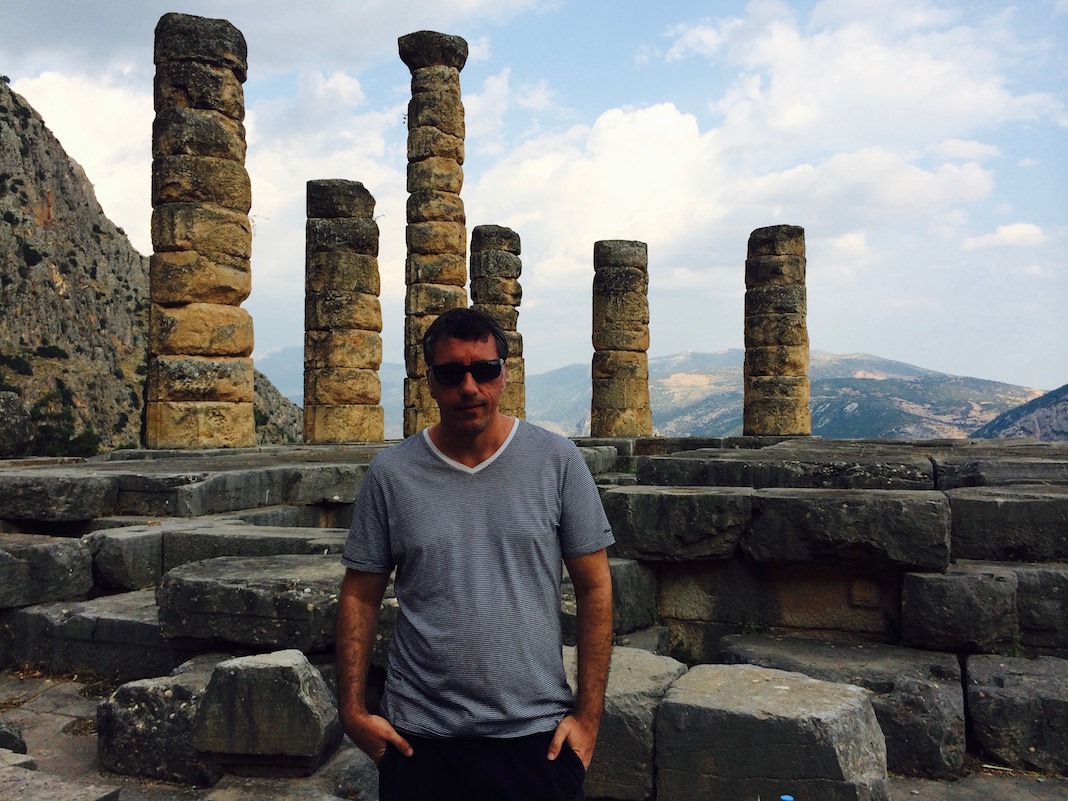
Here’s my photo.
How long should you stay in Delphi
If you want to see and do all of things to do in Delphi shown here you will probably need about 7 days all up to do so.
I personally think at least two nights in Delphi is the way to go at the very least.
Whatever you do, don’t rush and try to do a day trip to Delphi, because visiting Delphi in one day would be way too hectic in my opinion.
Stay for one night at the very least like I did so you can watch the sunset, take it easy and chill out a bit.
I caught the early morning bus from Athens and arrived in Delphi at around midday. It takes about 3 hours to get there from Athens, as Delphi is approximately 200km away.
You can imagine how hellish it would be if you went on a day trip to Delphi without an overnight stay.
Most of the day would be spent in the car or on a bus. Not to mention the fact that you would be madly rushing around to see only a few key attractions.
There you have it, the 23 best attractions in Delphi. Hope this inspires someone to visit this beautiful part of the world one day.


